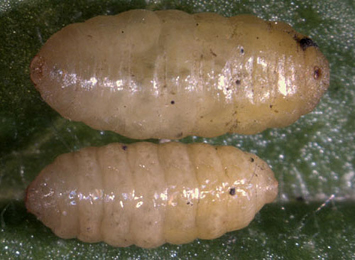|
||||||
|
CONIUM. Hemlock. [Apiaceae] |
|
Hemlock (C. maculatum), is the only species of Conium recorded in Britain. It is a native species. Four British miners are recorded on Conium. A key to the European miners recorded on Conium is provided in Bladmineerders van Europa. |
Key for the identification of the known mines of British |
1a > Leaf miner: A large blotch, yellow or brown, preceded by a short corridor that in the end mostly is completely overrun. Generally several larvae share a mine. Especially in fresh mines the green primary and secondary feeding lines are well visible. Pupation outside the mine. Puparium yellow. |
 Euleia heraclei pupariria Image: © Willem Ellis (Bladmineerders van Europa) |
|
Euleia heraclei (Linnaeus, 1758) [Diptera: Tephritidae]. |
1b > Leaf miner: Mine linear, greenish. Larva makes an exit slit through the upper surface and the puparium remains glued to leaf beyond the end of the mine (Spencer, 1972b: 76 (fig. 249, 81). Very shallow upper-surface corridor, often following the leaf margin. Frass in two rows, often forming pearl chains. Pupation outside the mine; exit slit in upper epidermis. The puparium is often found stuck to the leaf. |
|
Phytomyza conii Hering, 1931 [Diptera: Agromyzidae]. |
1c > Leaf-miner: A short, narrow, linear mine, generally closely following margin of leaf segment; in very small sections of a leaf producing a secondary blotch (Spencer, 1972b: 89 (fig. 302), 92; Spencer, 1976: 401 (fig. 702), 402). Upper-surface corridor, in the end widening so strongly that within the limited space of an umbelliferous leaf often a secondary blotch is the result. The upper-surface mine is preceded by a short lower-surface corridor, made by the first instar larva during the first part of this stage (Allen, 1956a). It is difficult to observe, also because it tends to follow the leaf margin. Frass in two untidy rows of isolated grains. Before pupation the larva leaves the mine through a semicircular exit slit in the lower epidermis. A narrow mine, follows leaf marginand forms secondary blotches. |
 Phytomyza chaerophylli puparium Image: © Willem Ellis (Bladmineerders van Europa) |
|
Phytomyza chaerophylli Kaltenbach, 1856 [Diptera: Agromyzidae]. |
1d > Leaf-miner: The larvae are often gregarious and feed on the underside of the leaf causing a 'windowing' effect as they eat the mesophyll and lower epidermis. This effect can be seen from the top of the leaf as it discolours. Short, small, irregular, sometimes widened corridor. Mostly a number in a leaf, concentrated in the axils of the midrib and the primary side veins. Each larva makes a number of mines. Often the larva protrudes with its rear end out of the mine, causing most frass to be ejected. While moving, at the leaf underside, silken threads are produced, in wich grains of frass may be trapped. Older larvae live free and cause window feeding, often in a group under a light spinning. |
|
Epermenia chaerophyllella (Goeze, 1783) [Lepidoptera: Epermeniidae]. |
| Last updated 02-Jul-2019 Brian Pitkin | ||
